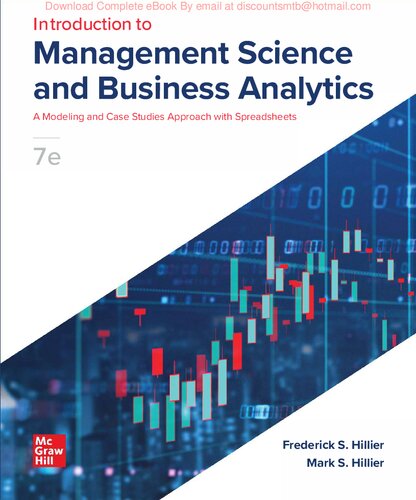Introduction to Management Science A Modeling and Case Studies Approach with Spreadsheets 7th Edition by Frederick Hillier, Mark Hillier 126546152X 9781265461522
$50.00 Original price was: $50.00.$25.00Current price is: $25.00.
Introduction to Management Science A Modeling and Case Studies Approach with Spreadsheets 7th Edition by Frederick Hillier, Mark Hillier – Ebook PDF Instant Download/Delivery: 126546152X, 9781265461522
Full download Introduction to Management Science A Modeling and Case Studies Approach with Spreadsheets 7th Edition after payment

Product details:
ISBN 10: 126546152X
ISBN 13: 9781265461522
Author: Frederick Hillier, Mark Hillier
Management Science and Business Analytics 7e has more focus on business analytics in this edition and can be used in a traditional Management Science Sequence or in a Business Analytics program where there is a focus on modeling. Resources include Connect, auto-graded assessment including exercises and test bank content.
Introduction to Management Science A Modeling and Case Studies Approach with Spreadsheets 7th Table of contents:
Chapter 1: Introduction
Introduction
1.1 The Nature of Management Science
Management Science Is a Discipline
Management Science Aids Managerial Decision Making
Management Science Uses a Scientific Approach
Management Science Considers Quantitative Factors
1.2 What is Business Analytics?
The Three Categories of Business Analytics
The Role of Data Science
The Role of Machine Learning
The Role of Artificial Intelligence
1.3 The Relationship Between Management Science and Business Analytics
The Increasing Demand for Business Analytics and Management Science Professionals
1.4 A Case Study: The VRX Company Advertising Budget Problem
Performing Descriptive Analytics to Explore the Data and Better Visualize the Impact of Advertising on Sales
Performing Predictive Analytics to Predict the Impact of Advertising on Sales
Performing Prescriptive Analytics to Determine the Best Advertising Level
1.5 The Impact of Management Science and Business Analytics
1.6 Some Special Features of This Book
1.7 Summary
Glossary
Learning Aids for This Chapter
Solved Problems
1.S1 Choosing an Advertising Budget
Problems
Case 1-1: VRX Revisited: Updating the Model with New Data Over Time
VRX Revisited: Updating the Model with New Data Over Time
Chapter 2: Overview of the Analysis Process
Introduction
2.1 A Case Study: First Bank Evaluates Applications for Unsecured Loans
2.2 Define the Problem
The Complementary Roles of the Study Team and Management
Additional Problem Definition Needed for Prescriptive Analytics
Returning to the Case Study: Defining the Problem at First Bank
2.3 Performing Descriptive Analytics
Returning to the Case Study: Gather and Organize the Relevant Data for First Bank
Some Terminology for Descriptive Analytics
Returning to the Case Study: Cleaning the Data at First Bank
Using Analytic Solver to Explore the Data
Returning to the Case Study: Explore the Data at First Bank
Explore the Data with Summary Statistics for First Bank
Explore the Data with Sorting and Filtering at First Bank
Explore the Data Visually at First Bank
2.4 Performing Predictive Analytics
Prediction and Classification Models
Some Terminology for Prediction and Classification Models
Returning to the Case Study: Developing the Model at First Bank
Choosing the Variables to Include in the Model at First Bank
Choosing the Algorithm for the Model at First Bank
Overfitting the Data
Partition the Data
Returning to the Case Study: Partition the Data at First Bank
Returning to the Case Study: Testing the KNN Model at First Bank
The Role of Lift Charts in Assessing the Effectiveness of an Algorithm
Refining the KNN Model at First Bank
Returning to the Case Study: Exploring Several Models and Choosing the Best
Returning to the Case Study: Implementing the Model at First Bank
2.5 Performing Prescriptive Analytics
Returning to the Case Study: Formulating a Decision Model for First Bank
2.6 Summary
Glossary
Learning Aids for This Chapter
Solved Problem
2.S1 Category D Loan Applicants at First Bank
Problems
Case 2-1: Vacations at Vegas Villas
Vacations at Vegas Villas
Chapter 3: Classification and Prediction Models for Predictive Analytics
Introduction
3.1 A Case Study: The Evergreen Solar Predictive Analytics Problem
3.2 Models Based on the k-Nearest-Neighbors (Knn) Algorithm
Summary of the KNN Algorithm
Finding the Nearest Neighbors for the Case Study
The Importance of Rescaling the Data Appropriately
Choosing k = Number of Historical Records to Include in the Prediction
Predicting Numerical Outcomes with the KNN Algorithm
Using Analytic Solver to Apply the KNN Algorithm to the Case Study
Pros and Cons of the KNN Algorithm
3.3 Models Based On Classification Tree And Regression Tree Algorithms
Introduction to the Classification Tree Algorithm
Splitting the Historical Records into Regions for the Case Study
Measuring Homogeneity with the Gini Index
Classification Trees
Further Splitting of the Data Set
Avoid Overfitting the Data
The Final Classification Tree for the Case Study
Executing the Matching Step
Executing the Classification Step
Making Numerical Predictions with Regression Trees
Using Analytic Solver to Apply These Algorithms to the Case Study
Using Analytic Solver Data Mining to Apply the Regression Tree Algorithm
Pros and Cons of Classification Tree and Regression Tree Algorithms
3.4 Other Models Based on Algorithms for Classification and Prediction
The Naïve Bayes Algorithm
Complete Bayes (Direct Method)
A Major Flaw with Complete Bayes
Naïve Bayes
Multiple Linear Regression
Logistic Regression
Choosing the Best Algorithm
3.5 Revisiting the Case Study: Refining and Testing the Models
Apply Data Partitioning to Refine the KNN Model by Choosing the Best Value for k
Apply Data Partitioning to Prune the Classification Tree
Applying Data Partitioning to Test the Various Models
3.6 Affinity Analysis and Recommendation Systems
3.7 Summary
Glossary
Learning Aids for This Chapter
Solved Problems
3.S1 Applying Classification Trees to First Bank
3.S2 Comparing Classification Models for Evergreen Solar
3.S3 Comparing Prediction Models for Evergreen Solar
Problems
Case 3-1: Evergreen Solar Decides to Use Naïve Bayes
Evergreen Solar Decides to Use Naïve Bayes
Case 3-2: Revisiting Vacations at Vegas Villas
Revisiting Vacations at Vegas Villas
Chapter 4: Predictive Analytics Based on Traditional Forecasting Methods
Introduction
4.1 An Overview of the Techniques of Time Series Forecasting
A Forecasting Problem
Some Forecasting Techniques
4.2 A Case Study: The Computer Club Warehouse (CCW) Problem
The CCW Call Center
The Call Center Manager, Lydia Weigelt
Lydia’s Current Forecasting Method
The Plan to Find a Better Forecasting Method
4.3 Applying Time Series Forecasting Methods to the Case Study
Considering Seasonal Effects
The Seasonally Adjusted Time Series
The Last-Value Forecasting Method
The Averaging Forecasting Method
The Moving-Average Forecasting Method
The Exponential Smoothing Forecasting Method
Exponential Smoothing with Trend
The Meeting with the Marketing Manager
Forecasting Software
4.4 The Time Series Forecasting Methods in Perspective
The Goal of the Forecasting Methods
Problems Caused by Shifting Distributions
Comparison of the Forecasting Methods
The Consultant’s Recommendations
4.5 Causal Forecasting with Linear Regression
Causal Forecasting
Linear Regression
The CCW Case Study a Year Later
4.6 Judgmental Forecasting Methods
4.7 Summary
Glossary
Summary of Key Formulas
Learning Aids for This Chapter
Solved Problem
4.S1 Forecasting Charitable Donations at the Union Mission
Problems
Case 4-1: Finagling the Forecasts
Finagling the Forecasts
Chapter 5: Linear Programming: Basic Concepts
Introduction
5.1 A Case Study: The Wyndor Glass Co. Product-Mix Problem
Background
Management’s Discussion of the Issues
The Analytics Department Begins Its Work
5.2 Formulating the Wyndor Problem on a Spreadsheet
Formulating a Spreadsheet Model for the Wyndor Problem
This Spreadsheet Model Is a Linear Programming Model
Characteristics of a Linear Programming Model on a Spreadsheet
Summary of the Formulation Procedure
5.3 The Mathematical Model in the Spreadsheet
Formulating the Wyndor Model Algebraically
Algebraic Model
Terminology for Linear Programming Models
Assumptions of Linear Programming Models
Comparisons of Algebraic Models and Spreadsheet Models
5.4 The Graphical Method for Solving Two-Variable Problems
Summary of the Graphical Method
5.5 Using Excel’s Solver to Solve Linear Programming Problems
5.6 Analytic Solver
5.7 A Minimization Example—the Profit & Gambit Co. Advertising-Mix Problem
Planning an Advertising Campaign
Formulating a Spreadsheet Model for This Problem
Applying Solver to This Model
The Mathematical Model in the Spreadsheet
5.8 Linear Programming from a Broader Perspective
5.9 Summary
Glossary
Learning Aids for This Chapter
Solved Problem
5.S1 Back Savers Production Problem
5.S2 Conducting a Marketing Survey
Problems
Case 5-1: Auto Assembly
Auto Assembly
Case 5-2: Cutting Cafeteria Costs
Cutting Cafeteria Costs
Case 5-3: Staffing a Call Center
Staffing a Call Center
People also search for Introduction to Management Science A Modeling and Case Studies Approach with Spreadsheets 7th:
modelling definition science
introduction to management science hillier
introduction to management science
introduction to management science taylor
introduction to management science 13th edition
Tags:
Frederick Hillier,Mark Hillier,management Science
You may also like…
Mathematics - Optimization. Operations Research
Introduction to Operations Research, 11e ISE Frederick S. Hillier
Education Studies & Teaching - Educational Theory
Business & Economics - Management & Leadership
An Introduction to Management Science: Quantitative Approach 15th Edition David R. Anderson
Chemistry - Chemistry - General & Miscellaneous
Medicine - Others
Business & Economics - Others
Computers - Applications & Software











